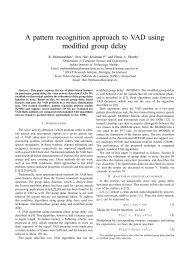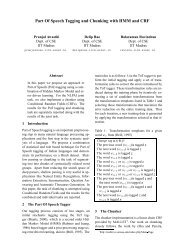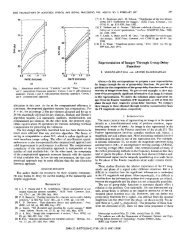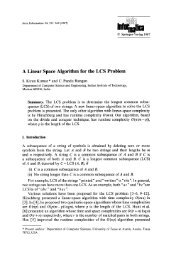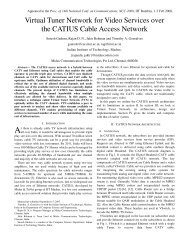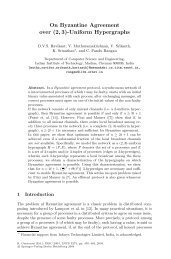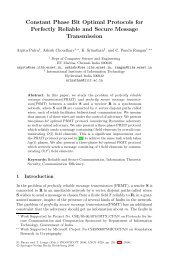TRANS: Schema-Aware Mapping of OWL Ontologies into Relational ...
TRANS: Schema-Aware Mapping of OWL Ontologies into Relational ...
TRANS: Schema-Aware Mapping of OWL Ontologies into Relational ...
Create successful ePaper yourself
Turn your PDF publications into a flip-book with our unique Google optimized e-Paper software.
Similar to ontology object property hierarchy, <strong>TRANS</strong><br />
maps each disjoint directed acyclic graph for ontology<br />
data property hierarchy <strong>into</strong> a relation DataProperty.<br />
In the DataProperty relation IndivURI and<br />
Value together make primary key. Ontology data<br />
property subsumption information is mapped to<br />
store_dplevel relation. Here store_dplevel relation<br />
stores all the transitive chains <strong>of</strong> the ontology<br />
data property hierarchy.<br />
Rule 4: Class disjointness<br />
RM: store_level[TransCId INT, CId INT,<br />
CURI VARCHAR(130), Level INT,<br />
DisjointId INT]<br />
UNIQUE [Transcid, Disjointid]<br />
Here we check the Disjointness <strong>of</strong> two classes by<br />
DisjointId attributes. If two classes are disjoint then<br />
they can not lie in the same transitive chain. Transcid<br />
and Disjointid together make primary key.<br />
Rule 5: Property domain and range<br />
RM: PropDomain[PId INT, DomainClasses INT]<br />
PRIMARY KEY [PId, DomainClasses]<br />
RM: PropRange[PId INT,<br />
PRIMARY KEY [PId, RangeClasses]<br />
RangeClasses INT]<br />
Property Domain and Range information is mapped<br />
to PropDomain and PropRange relation respectively.<br />
In PropDomain relation, PId and DomainClasses<br />
together make primary key. In PropRange relation,<br />
PId and RangeClasses together make primary key.<br />
Rule 6: Relations for storing clustering<br />
data information<br />
RM: Cluser_Class[ClusterCId INT, CId INT]<br />
PRIMARY KEY [ClusterCId INT, CId INT]<br />
RM: Cluster_Property[ClusterPId INT, PId INT]<br />
PRIMARY KEY [ClusterPId INT, PId INT]<br />
These relations stores newly created clustered<br />
classes and properties out <strong>of</strong> <strong>TRANS</strong> cluster operation.<br />
In Cluster_Class relation, ClusterCId and CId<br />
together make primary key. In Cluster_Property relation<br />
ClusterPId and PId together make primary key.<br />
2.2 Preprocessor<br />
The preprocessor preprocesses the ontology concept<br />
hierarchy using the Pellet[10, 12] reasoner. A set <strong>of</strong><br />
transitive chains is extracted out <strong>of</strong> ontology concept<br />
hierarchy by algorithm 1. The algorithm 1 also assigns<br />
a level number to each node in the transitive<br />
chain. Here level number <strong>of</strong> a node in a transitive<br />
chain is equal to its distance from the root node + 1.<br />
All the extracted transitive chains are populated <strong>into</strong><br />
the transitive chain relations created by rule 1, 2 and<br />
3. Algorithm 1 describes the transitive chain creation<br />
for ontology class hierarchy. Same transitive chain creation<br />
is done for the ontology property hierarchy also.<br />
input : O, An <strong>OWL</strong> ontology file<br />
output: A set <strong>of</strong> <strong>OWL</strong> class transitive chains<br />
and corresponding levels<br />
begin<br />
for Each root class R ɛ<br />
RootHierarchyClasses (O) do<br />
Transid ←− 1 ;<br />
Transid = Transid + 1 ;<br />
Print (Transid);<br />
Push (R);<br />
PrintTransChain(R);<br />
end<br />
PrintTransChain (R)<br />
begin<br />
Leaf ←− 0 ;<br />
for Each each S ɛ subClassOf (R) do<br />
Leaf ←− 1 ;<br />
Push (S);<br />
PrintTransChain (S);<br />
if Leaf = 0 then<br />
PrintStackElements ();<br />
if StackNotEmpty () then<br />
Pop ();<br />
end<br />
PrintStackElements ()<br />
begin<br />
Level ←− 1 ;<br />
while IterateAllStackElements () = False<br />
do<br />
PrintStackElement ();<br />
Print (Level);<br />
Level ←− Level + 1 ;<br />
end<br />
Algorithm 1: <strong>OWL</strong> Class Trans chain creation<br />
algorithm<br />
2.3 Transitive Chain Level Normalizer<br />
The transitive chain level normalizer normalizes the<br />
level numbers <strong>of</strong> nodes in the transitive chains created<br />
by algorithm 1. Normalization is the process <strong>of</strong> giving<br />
unique level number to each node. Algorithm 2<br />
describes the transitive chain level normalization pro-



